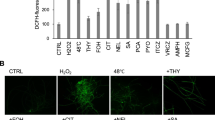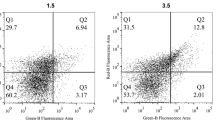Abstract
The effects of nitric oxide (NO) on spore germination of Penicillium expansum were investigated and a possible mechanism was evaluated. The results indicated that NO released by sodium nitroprusside (SNP) significantly suppressed fungal growth. With the use of an oxidant sensitive probe and Western blot analysis, an increased level of intracellular reactive oxygen species (ROS) and enhanced carbonylation damage were detected in spores of P. expansum under NO stress. Exogenous superoxide dismutase (SOD) and ascorbic acid (Vc) could increase the resistance of the spore to the inhibitory effect of NO. The activities of SOD and catalase (CAT), as well as ATP content in spores under NO stress were also lower than those in the control. We suggest that NO in high concentration induces the generation of ROS which subsequently causes severe oxidative damage to proteins crucial to the process of spore germination of P. expansum.





Similar content being viewed by others
References
Beltrán B, Mathur A, Duchen MR et al (2000) The effect of nitric oxide on cell respiration: a key to understanding its role in cell survival or death. Proc Natl Acad Sci USA 97:14602–14617
Brown GC (1995) Reversible binding and inhibition of catalase by nitric oxide. Eur J Biochem 232:188–191
Carreras MC, Franco MC, Peralta JG et al (2004) Nitric oxide, complex I, and the modulation of mitochondrial reactive species in biology and disease. Mol Aspects Med 25:125–139
Carreras MC, Poderoso JJ (2008) Mitochondrial nitric oxide in the signaling of cell integrated responses. Am J Physiol Cell Physiol 292:1569–1580
Chen CB, Dickman MB (2005) Proline suppresses apoptosis in the fungal pathogen Colletotrichum trifolii. Proc Natl Acad Sci USA 102:3459–3462
Fang FC (1997) Mechanism of nitric oxide-related antimicrobial activity. J Clin Invest 99:2818–2825
Giulivi C, Kato K, Cooper CE (2006) Nitric oxide regulation of mitochondrial oxygen consumption I: cellular physiology. Am J Physiol Cell Physiol 291:1225–1231
Lazar EE, Wills RBH, Ho BT et al (2008) Antifungal effect of gaseous nitric oxide on mycelium growth, sporulation and spore germination of the postharvest horticulture pathogens, Aspergillus niger, Monilinia fructicola and Penicillium italicum. Lett Appl Microbiol 46:688–692
Marek P, Annamalai T, Venkitanarayanan K (2003) Detection of Penicillium expansum by polymerase chain reaction. Int J Food Microbiol 89:139–144
Mur LAJ, Carver TLW, Prats E (2006) NO way to live; the various role of nitric oxide in plant-pathogen interactions. J Exp Bot 57:489–502
Nisoli E, Carruba MO (2006) Nirtic oxide and mitochondrial biogenesis. J Cell Sci 119:2855–2862
Qin GZ, Tian SP (2005) Enhancement of biocontrol activity of Cryptococcus laurentii by silicon and possible mechanisms involved. Phytopathology 1:69–75
Qin GZ, Tian SP, Chan ZL et al (2007) Crucial role of antioxidant proteins and hydrolytic enzymes in pathogenicity of Penicillium expansum. Mol Cell Proteomics 14:425–438
Stewart VC, Sharpe MA, Clark JB et al (2000) Astrocyte-derived nitric oxide cause both reversible and irreversible damage to the neuronal mitochondrial respiratory chain. J Neurochem 75:694–699
Thomas DD, Ridnour LA, Isenberg JS et al (2008) The chemical biology of nitric oxide: implications in cellular signaling. Free Radical Bio Med 45:18–31
Tian SP, Yao HJ, Deng X et al (2007) Characterization and expression of β-1,3-glucanase genes in jujube fruit induced by the microbial biocontrol agent Cryptococcus laurentii. Phytopathology 3:261–268
Wang J, Higgins VJ (2005) Nitric oxide has a regulatory effect on the germination of conidia of Colletotrichum coccodes. Fungal Genet Biol 42:284–292
Wang Y, Tian SP, Xu Y (2005) Effects of high oxygen concentration on pro- and anti-oxidant enzymes in peach fruits during postharvest periods. Food Chem 91:99–104
Wills RBH, Ku VVV, Leshem YY (2000) Fumigation with nitric oxide to extend the postharvest life of strawberries. Postharvest Biol Technol 19:75–79
Wink DA, Hanbauer I, Grisham MB et al (1996) Chemical biology of nitric oxide: regulation and protective and toxic mechanisms. Curr Top Cell Regul 34:159–187
Wink DA, Mitchell JB (1998) Chemical biology of nitric oxide: insights into regulatory, cytotoxic, and cytoprotective mechanisms of nitric oxide. Free Radic Biol Med 25:434–456
Acknowledgments
This study was supported by National Basic Research Program of China (973 Program) Grant (2006CB1019007), the National Natural Science Foundation of China (30972069), and the Ministry of Science and Technology of China (2006BAD22B02).
Author information
Authors and Affiliations
Corresponding author
Rights and permissions
About this article
Cite this article
Lai, T., Li, B., Qin, G. et al. Oxidative Damage Involves in the Inhibitory Effect of Nitric Oxide on Spore Germination of Penicillium expansum . Curr Microbiol 62, 229–234 (2011). https://doi.org/10.1007/s00284-010-9695-1
Received:
Accepted:
Published:
Issue Date:
DOI: https://doi.org/10.1007/s00284-010-9695-1




